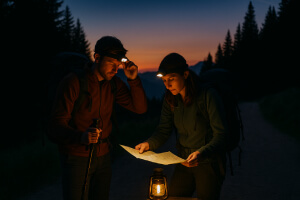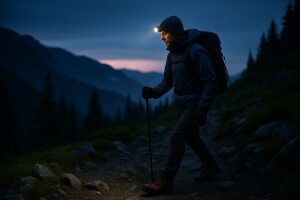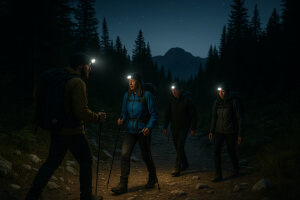Hiking at night gives a different perspective of the outdoors. The setting sun reveals nocturnal wildlife, stars, and serene trails, but also brings challenges like limited eyesight, dropping temperatures, and safety concerns. Proper preparation is key for a safe, pleasant, and memorable adventure.
Night hiking isn’t just holding a flashlight. One must prepare body, gear, and mind for unfamiliar terrain. Small errors, like a slip, can cause disorientation or injury. Below are tips on essential gear, trail planning, safety measures, and habits to maximize your night hikes.
Plan Ahead Before Night Hiking

Hiking preparation is the key before hitting the trail. Night hiking requires more planning than a daylight stroll because the hazards are more and resources are limited. Choose a trail that you are already familiar with, or an all-around well-marked and popular one. Avoid steep or rugged routes until you get comfortable finding your way in the dark. Check the weather because temperatures generally drop after sunset, and rain or fog can hamper visibility.
Remember to inform someone about your plans for the hike, including your estimated time to return and your route. Carry your phone or GPS with a full charge at all times, but consider that technology has been known to fail at times. Carrying an actual physical map and compass and being able to get your bearings on the terrain are wonderful substitutes on any occasion. Planning ahead guarantees a fun experience without surprises and fortifies your hiking safety along with that of your hiking companions.
Equip Yourself With Proper Lighting
Light stands at the very core of the entire night hike. Ideally, a headlamp should be used because it confers the advantage of having both hands free, either for clinging onto balance or to trekking poles or even for negotiating obstacles. The headlamp should be adjustable in terms of brightness and on long battery life. Always carry spare batteries or a backup light source as your battery could run out at the worst stage of the trail!
The type of light your source gives you. The wider and softer its beam, the better for your vision along the trail with peripheral obstacles in view, while the focused beam can assist you in recognizing far-off markers or even wildlife. The reflective clothes or accessories will enhance the visibility of their wearer to other hikers, especially in regions where bike or vehicle movement is possible. Proper lighting is what turns an otherwise risky hike into a manageable and even thrilling experience.
Dress for Nighttime Conditions

Night temperatures usually dip, though sometimes even in the summer months. Usually, layering helps one maintain comfort by removing or adding layers. Wear a moisture-wicking base layer that will keep sweat off your skin. Then put on insulating layers and a light-weight weather-resistant jacket to block wind or rain.
Always essential is footwear. Strong hiking boots with good grip must be chosen to provide resistance against slipping on rocks, roots, or wet surfaces. If you plan to hike during the colder months, thermal socks and gloves will keep you warmer without restricting your movements. Keep in mind that warmth, comfort, and mobility should all be prioritized equally. Night hiking almost always gets difficult when the gear stands in the way of freedom of movement or simply slows you down.
Navigate Carefully and Maintain Awareness
Night-time navigation calls for extra attention. Even well-known trails may appear different in the dark, and hazards like tree roots or rocky grounds become dangerous. Rather than rushing through big distances, keep your pace steady and manageable. Taking slower steps gives you time to react when unexpected obstacles come your way.
Try to invoke as many cues as possible, especially cues like: wildlife, water sources, or maybe other hikers. Stop every once in a while and take a look around to get your bearings using a map or a GPS. Night hiking requires very conscious observation, which can also lead to a more spiritual connection to nature.
Safety Practices for Night Hiking

Safety should be the highest priority for any nighttime hike. Always be with another person or group fewer than five for maximum safety. If someone falls, disorients, or any other types of emergency, the group will help. However, if you have to go on a solo hike again, have yourself double cautious: instruct someone about your course; carry a communication set for emergencies; and stay on bigger and well-marked trails.
Carry with you a small first-aid kit along with a whistle and an emergency kit having basic survival supplies like water, snacks, and a fire starter. Know your limits and be willing to call it off if anything goes awry or you feel weary. Night hiking boosts the risk factor, although right planning and continual assessing can reduce it drastically.
Maximize the Nighttime Experience
That said, a night is when hiking presents unique opportunities to interact with nature in ways impossible during the day. High above shine up the stars; listen to nocturnal wildlife for their murmur; notice familiar landscapes in the change of moon color. Bring your binocs and a star chart if you plan on stargazing. This slower-paced night hike opens a gateway to being mindful and appreciating more the environment surrounding you.
Stay Safe While Hiking at Night
Night hiking is great fun and glory in the wilderness; however, it needs preparation, appropriate gears, and some situational awareness. Every element, from planning the hike, light source, navigation, safety, and keeping wildlife enrichment in consciousness, comes into play. When steps are taken to keep the hiker safe, the night hike itself becomes very rewarding, having a stance on trails and landscape that daylight hiking can never provide.
